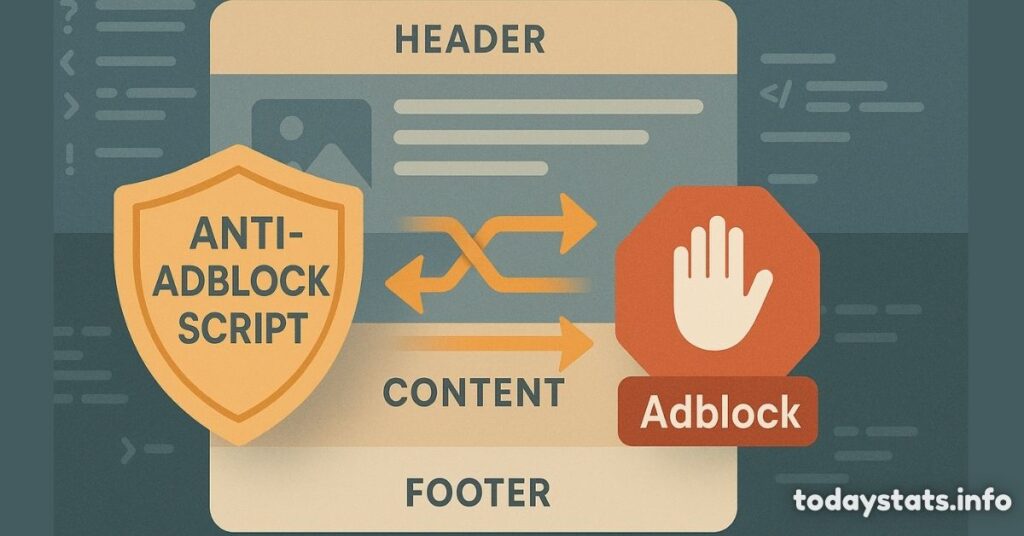adsy.pw/r is a redirection domain often used in anti-adblock scripts. These scripts detect users running ad blocking software and redirect them to other pages. These redirections usually serve ads or push notifications. This domain is a key example of how the digital ad ecosystem responds to ad blocker detection.
It plays a controversial role. On one side, it helps websites maintain their advertising revenue. On the other, it disrupts user experience by hijacking navigation.
Understanding how adsy.pw/r works is important for both users and web publishers. It highlights a growing tension in the online advertising world.
Understanding Anti-Adblock Mechanisms
Anti-adblock tools are designed to detect and respond when users block ads. They use JavaScript redirection, script execution, and even web filtering techniques to spot ad blocking circumvention.

Once detected, users might see messages asking them to disable ad blockers. In other cases, they are redirected to domains like adsy.pw/r.
These scripts serve one main purpose: revenue stream protection. Publishers spend time and resources creating content. Ads support this effort. But ad blocking software cuts that income. Anti-adblock technology is a way to fight back, ensuring website monetization remains possible.
Some scripts do more than just detect blockers. They may limit content access or inject alternative ads. This affects how users interact with a website. It also changes web interaction patterns and brings up important questions about user consent mechanisms.
How adsy.pw/r Functions?
| Steps | Function Description |
| 1 | A user visits a site with an ad blocker enabled. |
| 2 | The site detects the blocker using JavaScript ad blocker detection scripts. |
| 3 | Instead of loading the original content, the user is redirected to adsy.pw/r. |
| 4 | adsy.pw/r may display ads, initiate pop-ups, or route users to other advertiser pages. |
| 5 | After the redirection, users might be required to interact with ads before accessing the actual content. |
This process ensures advertising visibility even when traditional ad placements are blocked. It leverages web redirection and script execution to bypass user preferences.
READ THIS: Fix huzoxhu4.f6q5-3d Bug Fast: Step-by-Step Complete Guide
Impact on User Experience
User browsing disruption is one of the biggest effects. Redirects like those from adsy.pw/r break the natural flow of a website. Users click on a link, expect content, but get ads or warnings instead.
This leads to frustration. It can also increase bounce rates. Sites lose trust. Frequent users may look for alternatives. This harms digital content monetization in the long run, despite the short-term ad income.
Some users feel their user privacy considerations are being ignored. These redirections often involve data collection, ad tracking, and notifications. They shift focus from browsing behavior to aggressive ad tactics. As a result, overall user experience declines.
Technical Analysis
Technically, adsy.pw/r relies on embedded scripts. These scripts run checks using DOM analysis and event listeners. If ad blockers are found, redirection occurs. The scripts are obfuscated, making them hard to detect or disable.
Most operate in real-time. They monitor script loading times or element visibility. A hidden iframe, for example, may fail to load if an ad blocker is active. That failure is used as a signal. Once triggered, a redirect changes the window location to adsy.pw/r.
Some scripts also use fingerprinting techniques. These methods scan for browser extensions or known patterns linked to ad blockers. These advanced techniques blur the line between content access control and privacy invasion.
Bypassing adsy.pw/r Redirections
There are ways to bypass redirections from adsy.pw/r. Advanced ad blocking software now includes filters for these domains. Extensions like uBlock Origin and AdGuard have custom lists that stop redirects.

Users can manually blacklist the domain. Another method involves disabling JavaScript on specific sites. But that may break other website features. Proxy tools and DNS filtering are also helpful, but require technical skill.
It’s important to strike a balance. While users want smooth browsing, publishers seek income. Advertising ecosystem balance is key. Overblocking harms websites. Overenforcing alienates users. Smart filters that respect user consent and only block intrusive behavior are a middle ground.
READ THIS: Develop Oxzep7 Software: Unlock Your Team’s Ultimate Productivity Potential Today
Ethical and Legal Considerations
The ethics around anti-adblock redirection are complex. On one hand, publishers deserve web publisher sustainability. On the other, users should have control over their experience. Forced redirection can feel like user consent mechanisms are being bypassed.
There are also legal angles. In the EU, GDPR demands transparency in data use. Redirection scripts that collect data without consent may violate these rules. Similarly, browser extensions that override user intent may be seen as intrusive.
The ethical debate hinges on advertising compliance measures. Are redirections honest about their goals? Are users informed or just manipulated? These questions shape the future of digital publishing economics.
Alternatives for Publishers
Publishers have better options than aggressive redirection. They can use soft blockers. These gently ask users to allow ads. They might also offer premium ad-free content subscriptions.
Native advertising is another solution. These ads blend with content and don’t rely on traditional ad networks. They offer advertising effectiveness metrics without hurting the browsing experience.
Some publishers now test ad-light modes. These serve non-invasive ads even with blockers active. The key is transparency. Users value honesty. If told why ads matter and how they support content, many choose to whitelist.
Publishers should focus on web technology integration that respects both sides. Smart solutions, clear messaging, and sustainable habits create trust. In time, this improves online content sustainability and secures long-term growth.
Frequently Asked Questions
What is adsy.pw/r used for?
It redirects users when ad blockers are detected to serve ads or warnings.
Can I stop redirections from adsy.pw/r?
Yes, using advanced ad blockers or browser settings can block these redirects.
Is adsy.pw/r harmful to my computer?
It’s not a virus, but it can degrade your browsing experience.
Why do websites use adsy.pw/r?
To protect their ad revenue by bypassing ad blockers.
Are there legal risks for using anti-adblock scripts?
Yes, if they violate user consent laws or collect data without permission.
Conclusion
adsy.pw/r represents a larger shift in the fight between ad blockers and publishers. It shows how far some sites go to protect their digital revenue models. But at what cost? Users lose control. Trust fades. Browsing becomes frustrating.
Still, there are better ways. With smart design, web navigation can be enjoyable and profitable. Respecting privacy, using clear consent tools, and creating quality content is the way forward. For both users and publishers, understanding and cooperation are key.
The future of advertising technology evolution isn’t in forcing ads. It’s in balancing needs, building trust, and improving the experience for everyone involved in the advertising ecosystem.

Smith is a seasoned SEO expert with a passion for content writing, keyword research, and web development. He combines technical expertise with creative strategies to deliver exceptional digital solutions.
















